Operations and project management
VerifiedAdded on 2022/12/29
|15
|4158
|90
AI Summary
please follow the assigment brief
Contribute Materials
Your contribution can guide someone’s learning journey. Share your
documents today.
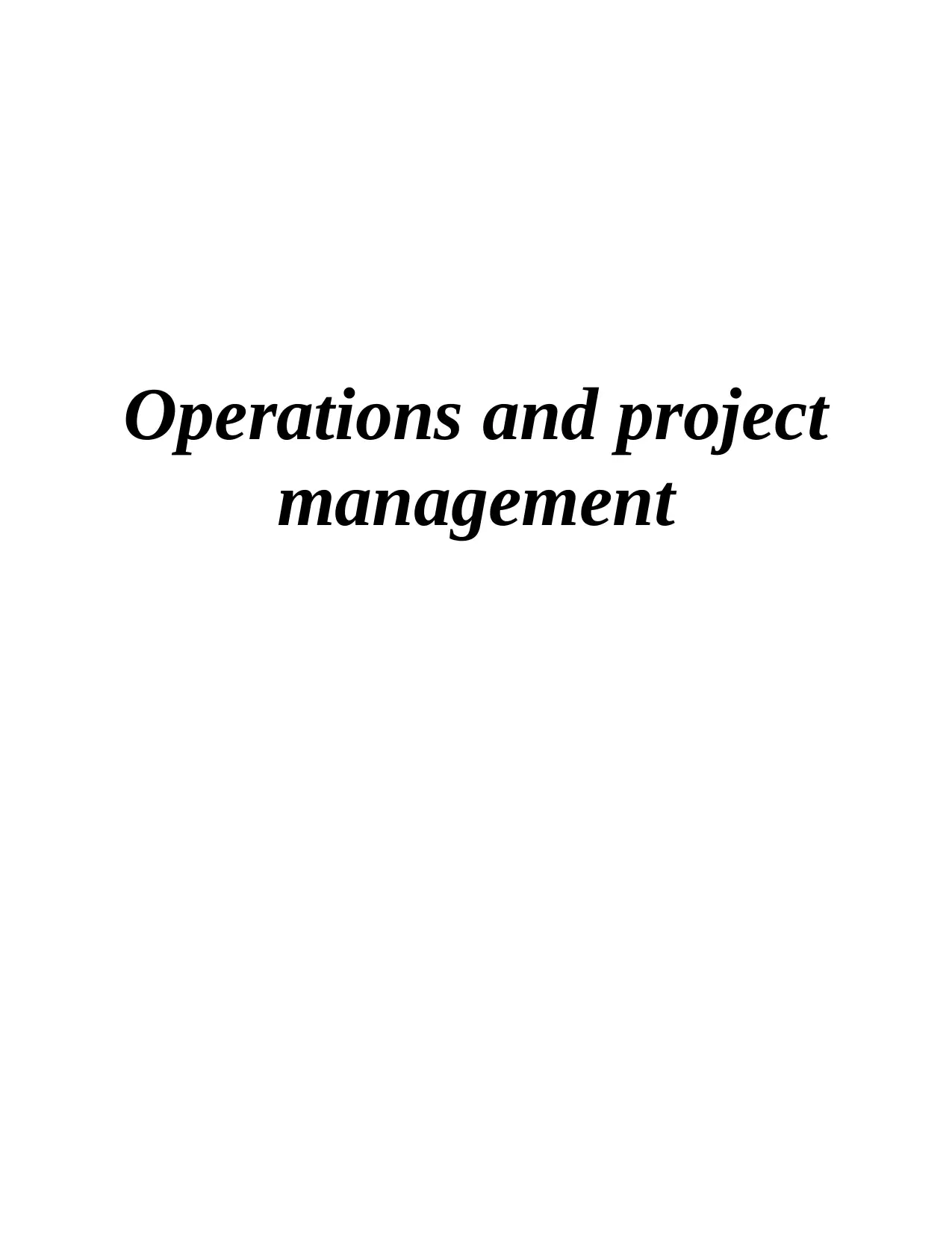
Operations and project
management
management
Secure Best Marks with AI Grader
Need help grading? Try our AI Grader for instant feedback on your assignments.
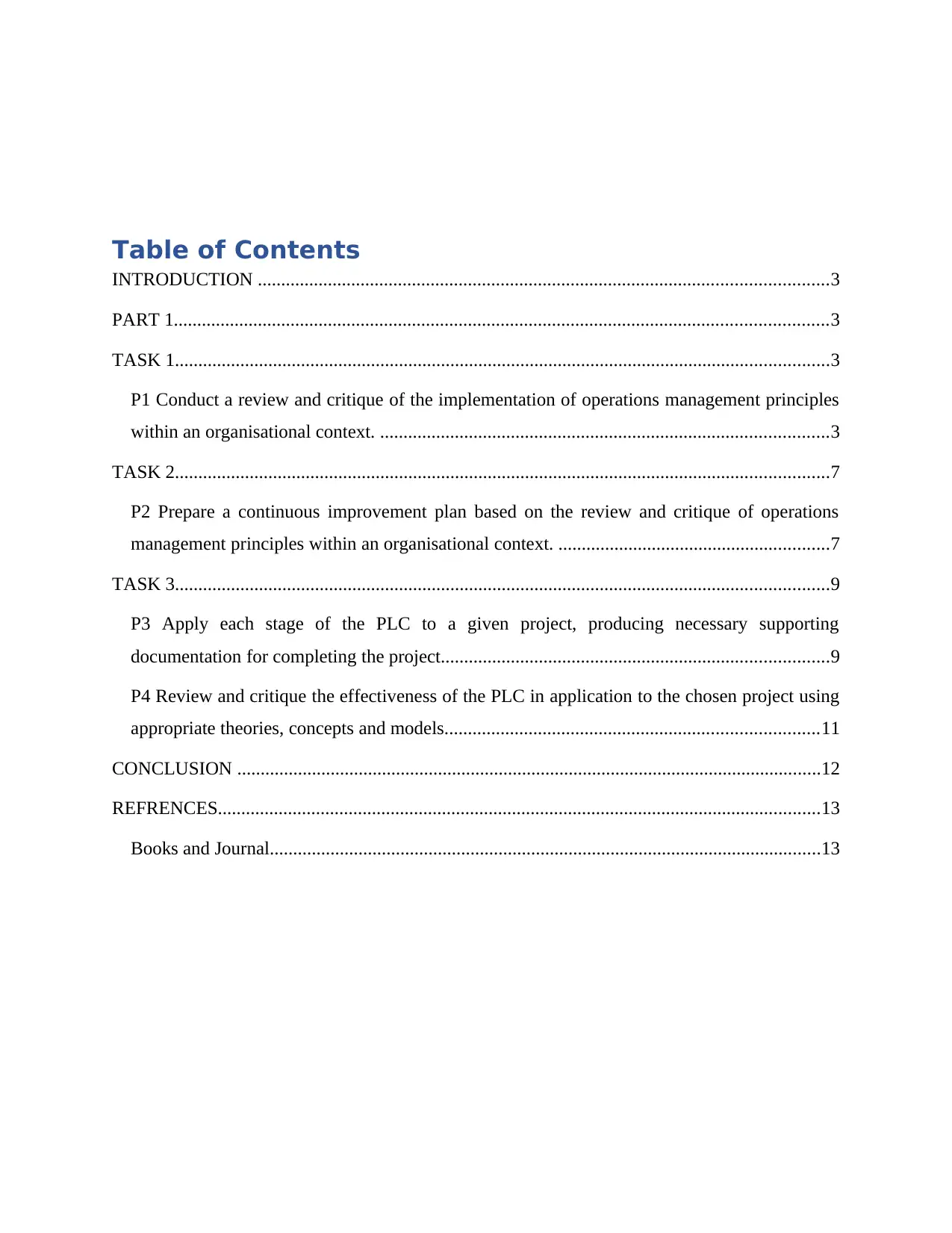
Table of Contents
INTRODUCTION ..........................................................................................................................3
PART 1............................................................................................................................................3
TASK 1............................................................................................................................................3
P1 Conduct a review and critique of the implementation of operations management principles
within an organisational context. ................................................................................................3
TASK 2............................................................................................................................................7
P2 Prepare a continuous improvement plan based on the review and critique of operations
management principles within an organisational context. ..........................................................7
TASK 3............................................................................................................................................9
P3 Apply each stage of the PLC to a given project, producing necessary supporting
documentation for completing the project...................................................................................9
P4 Review and critique the effectiveness of the PLC in application to the chosen project using
appropriate theories, concepts and models................................................................................11
CONCLUSION .............................................................................................................................12
REFRENCES.................................................................................................................................13
Books and Journal......................................................................................................................13
INTRODUCTION ..........................................................................................................................3
PART 1............................................................................................................................................3
TASK 1............................................................................................................................................3
P1 Conduct a review and critique of the implementation of operations management principles
within an organisational context. ................................................................................................3
TASK 2............................................................................................................................................7
P2 Prepare a continuous improvement plan based on the review and critique of operations
management principles within an organisational context. ..........................................................7
TASK 3............................................................................................................................................9
P3 Apply each stage of the PLC to a given project, producing necessary supporting
documentation for completing the project...................................................................................9
P4 Review and critique the effectiveness of the PLC in application to the chosen project using
appropriate theories, concepts and models................................................................................11
CONCLUSION .............................................................................................................................12
REFRENCES.................................................................................................................................13
Books and Journal......................................................................................................................13
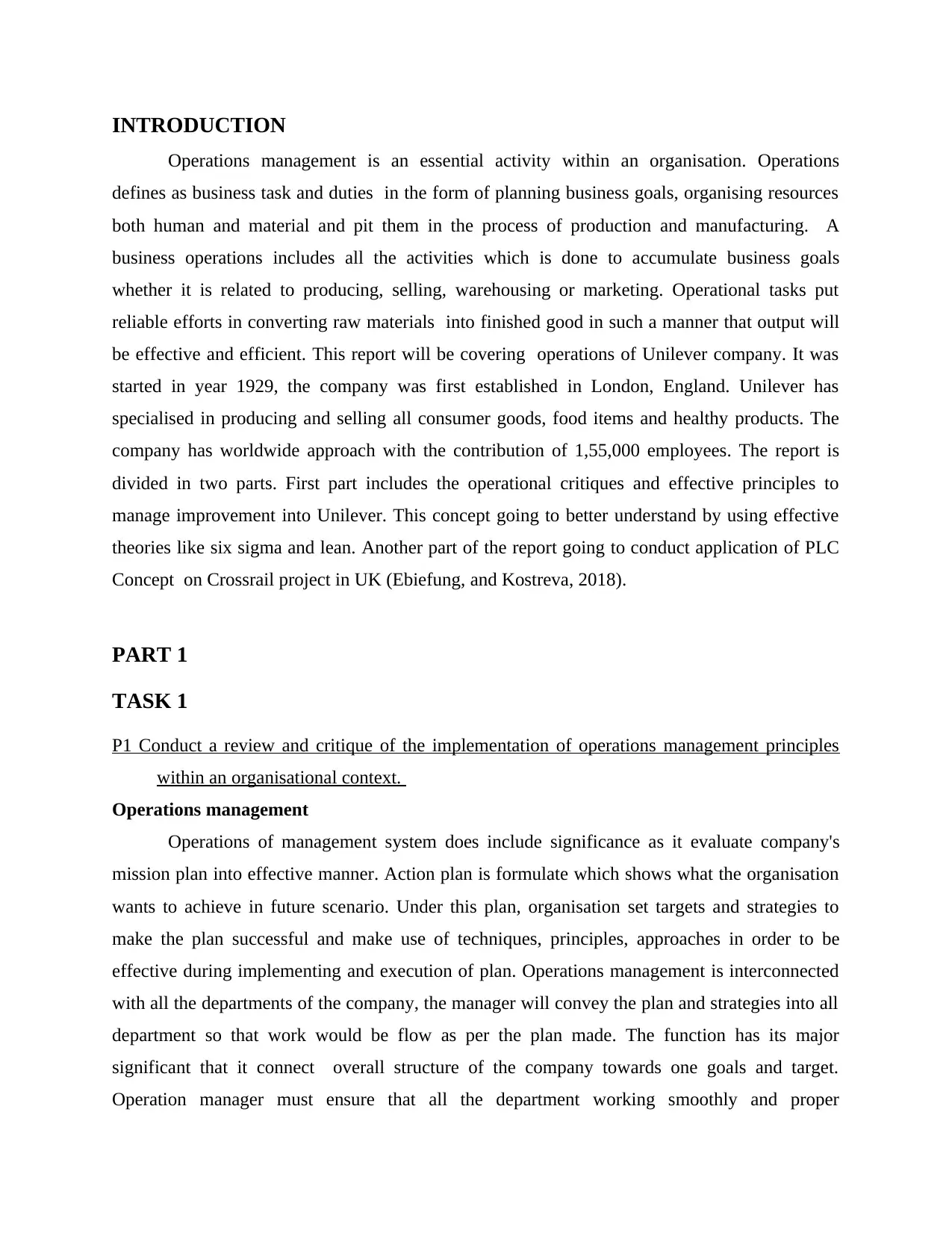
INTRODUCTION
Operations management is an essential activity within an organisation. Operations
defines as business task and duties in the form of planning business goals, organising resources
both human and material and pit them in the process of production and manufacturing. A
business operations includes all the activities which is done to accumulate business goals
whether it is related to producing, selling, warehousing or marketing. Operational tasks put
reliable efforts in converting raw materials into finished good in such a manner that output will
be effective and efficient. This report will be covering operations of Unilever company. It was
started in year 1929, the company was first established in London, England. Unilever has
specialised in producing and selling all consumer goods, food items and healthy products. The
company has worldwide approach with the contribution of 1,55,000 employees. The report is
divided in two parts. First part includes the operational critiques and effective principles to
manage improvement into Unilever. This concept going to better understand by using effective
theories like six sigma and lean. Another part of the report going to conduct application of PLC
Concept on Crossrail project in UK (Ebiefung, and Kostreva, 2018).
PART 1
TASK 1
P1 Conduct a review and critique of the implementation of operations management principles
within an organisational context.
Operations management
Operations of management system does include significance as it evaluate company's
mission plan into effective manner. Action plan is formulate which shows what the organisation
wants to achieve in future scenario. Under this plan, organisation set targets and strategies to
make the plan successful and make use of techniques, principles, approaches in order to be
effective during implementing and execution of plan. Operations management is interconnected
with all the departments of the company, the manager will convey the plan and strategies into all
department so that work would be flow as per the plan made. The function has its major
significant that it connect overall structure of the company towards one goals and target.
Operation manager must ensure that all the department working smoothly and proper
Operations management is an essential activity within an organisation. Operations
defines as business task and duties in the form of planning business goals, organising resources
both human and material and pit them in the process of production and manufacturing. A
business operations includes all the activities which is done to accumulate business goals
whether it is related to producing, selling, warehousing or marketing. Operational tasks put
reliable efforts in converting raw materials into finished good in such a manner that output will
be effective and efficient. This report will be covering operations of Unilever company. It was
started in year 1929, the company was first established in London, England. Unilever has
specialised in producing and selling all consumer goods, food items and healthy products. The
company has worldwide approach with the contribution of 1,55,000 employees. The report is
divided in two parts. First part includes the operational critiques and effective principles to
manage improvement into Unilever. This concept going to better understand by using effective
theories like six sigma and lean. Another part of the report going to conduct application of PLC
Concept on Crossrail project in UK (Ebiefung, and Kostreva, 2018).
PART 1
TASK 1
P1 Conduct a review and critique of the implementation of operations management principles
within an organisational context.
Operations management
Operations of management system does include significance as it evaluate company's
mission plan into effective manner. Action plan is formulate which shows what the organisation
wants to achieve in future scenario. Under this plan, organisation set targets and strategies to
make the plan successful and make use of techniques, principles, approaches in order to be
effective during implementing and execution of plan. Operations management is interconnected
with all the departments of the company, the manager will convey the plan and strategies into all
department so that work would be flow as per the plan made. The function has its major
significant that it connect overall structure of the company towards one goals and target.
Operation manager must ensure that all the department working smoothly and proper
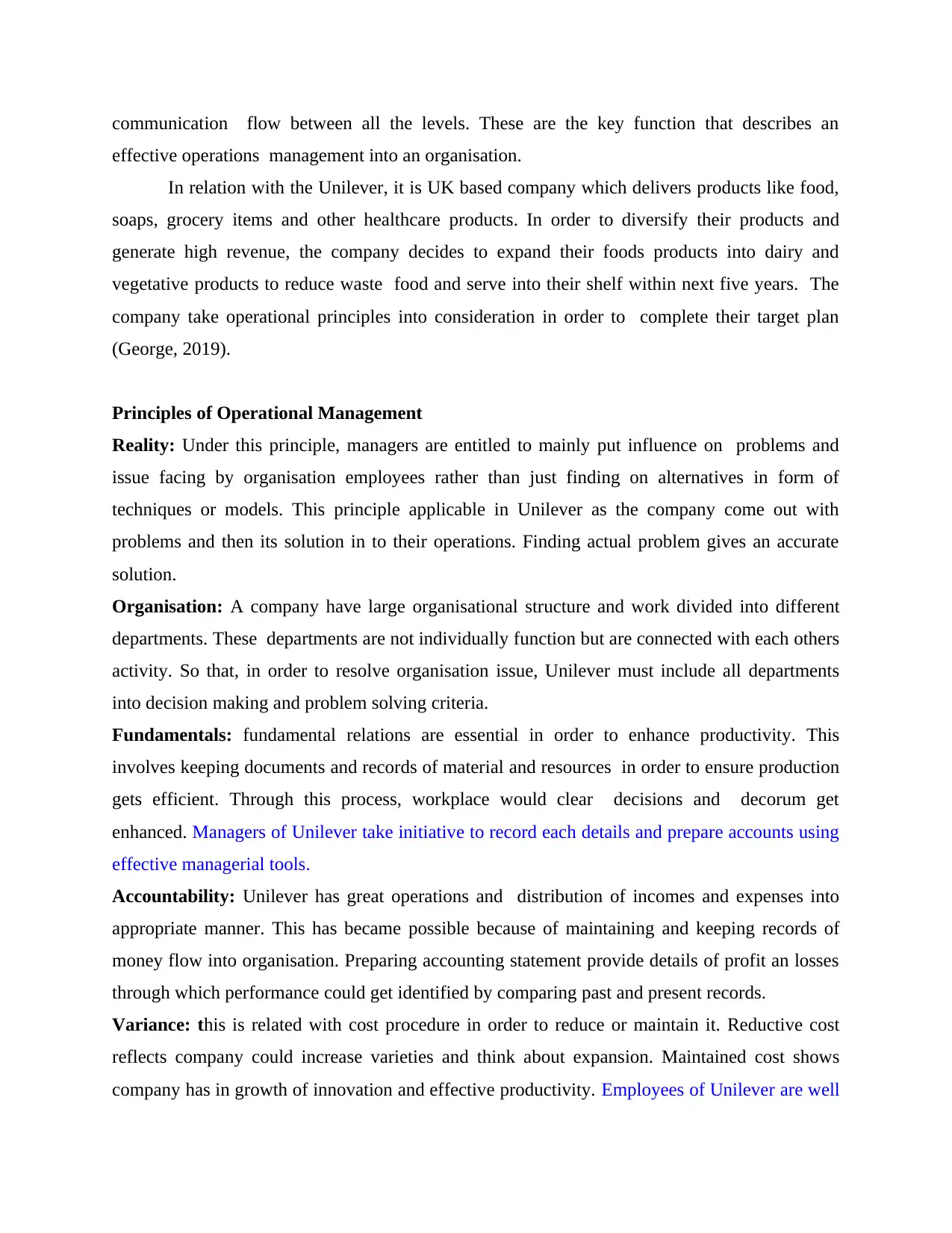
communication flow between all the levels. These are the key function that describes an
effective operations management into an organisation.
In relation with the Unilever, it is UK based company which delivers products like food,
soaps, grocery items and other healthcare products. In order to diversify their products and
generate high revenue, the company decides to expand their foods products into dairy and
vegetative products to reduce waste food and serve into their shelf within next five years. The
company take operational principles into consideration in order to complete their target plan
(George, 2019).
Principles of Operational Management
Reality: Under this principle, managers are entitled to mainly put influence on problems and
issue facing by organisation employees rather than just finding on alternatives in form of
techniques or models. This principle applicable in Unilever as the company come out with
problems and then its solution in to their operations. Finding actual problem gives an accurate
solution.
Organisation: A company have large organisational structure and work divided into different
departments. These departments are not individually function but are connected with each others
activity. So that, in order to resolve organisation issue, Unilever must include all departments
into decision making and problem solving criteria.
Fundamentals: fundamental relations are essential in order to enhance productivity. This
involves keeping documents and records of material and resources in order to ensure production
gets efficient. Through this process, workplace would clear decisions and decorum get
enhanced. Managers of Unilever take initiative to record each details and prepare accounts using
effective managerial tools.
Accountability: Unilever has great operations and distribution of incomes and expenses into
appropriate manner. This has became possible because of maintaining and keeping records of
money flow into organisation. Preparing accounting statement provide details of profit an losses
through which performance could get identified by comparing past and present records.
Variance: this is related with cost procedure in order to reduce or maintain it. Reductive cost
reflects company could increase varieties and think about expansion. Maintained cost shows
company has in growth of innovation and effective productivity. Employees of Unilever are well
effective operations management into an organisation.
In relation with the Unilever, it is UK based company which delivers products like food,
soaps, grocery items and other healthcare products. In order to diversify their products and
generate high revenue, the company decides to expand their foods products into dairy and
vegetative products to reduce waste food and serve into their shelf within next five years. The
company take operational principles into consideration in order to complete their target plan
(George, 2019).
Principles of Operational Management
Reality: Under this principle, managers are entitled to mainly put influence on problems and
issue facing by organisation employees rather than just finding on alternatives in form of
techniques or models. This principle applicable in Unilever as the company come out with
problems and then its solution in to their operations. Finding actual problem gives an accurate
solution.
Organisation: A company have large organisational structure and work divided into different
departments. These departments are not individually function but are connected with each others
activity. So that, in order to resolve organisation issue, Unilever must include all departments
into decision making and problem solving criteria.
Fundamentals: fundamental relations are essential in order to enhance productivity. This
involves keeping documents and records of material and resources in order to ensure production
gets efficient. Through this process, workplace would clear decisions and decorum get
enhanced. Managers of Unilever take initiative to record each details and prepare accounts using
effective managerial tools.
Accountability: Unilever has great operations and distribution of incomes and expenses into
appropriate manner. This has became possible because of maintaining and keeping records of
money flow into organisation. Preparing accounting statement provide details of profit an losses
through which performance could get identified by comparing past and present records.
Variance: this is related with cost procedure in order to reduce or maintain it. Reductive cost
reflects company could increase varieties and think about expansion. Maintained cost shows
company has in growth of innovation and effective productivity. Employees of Unilever are well
Secure Best Marks with AI Grader
Need help grading? Try our AI Grader for instant feedback on your assignments.
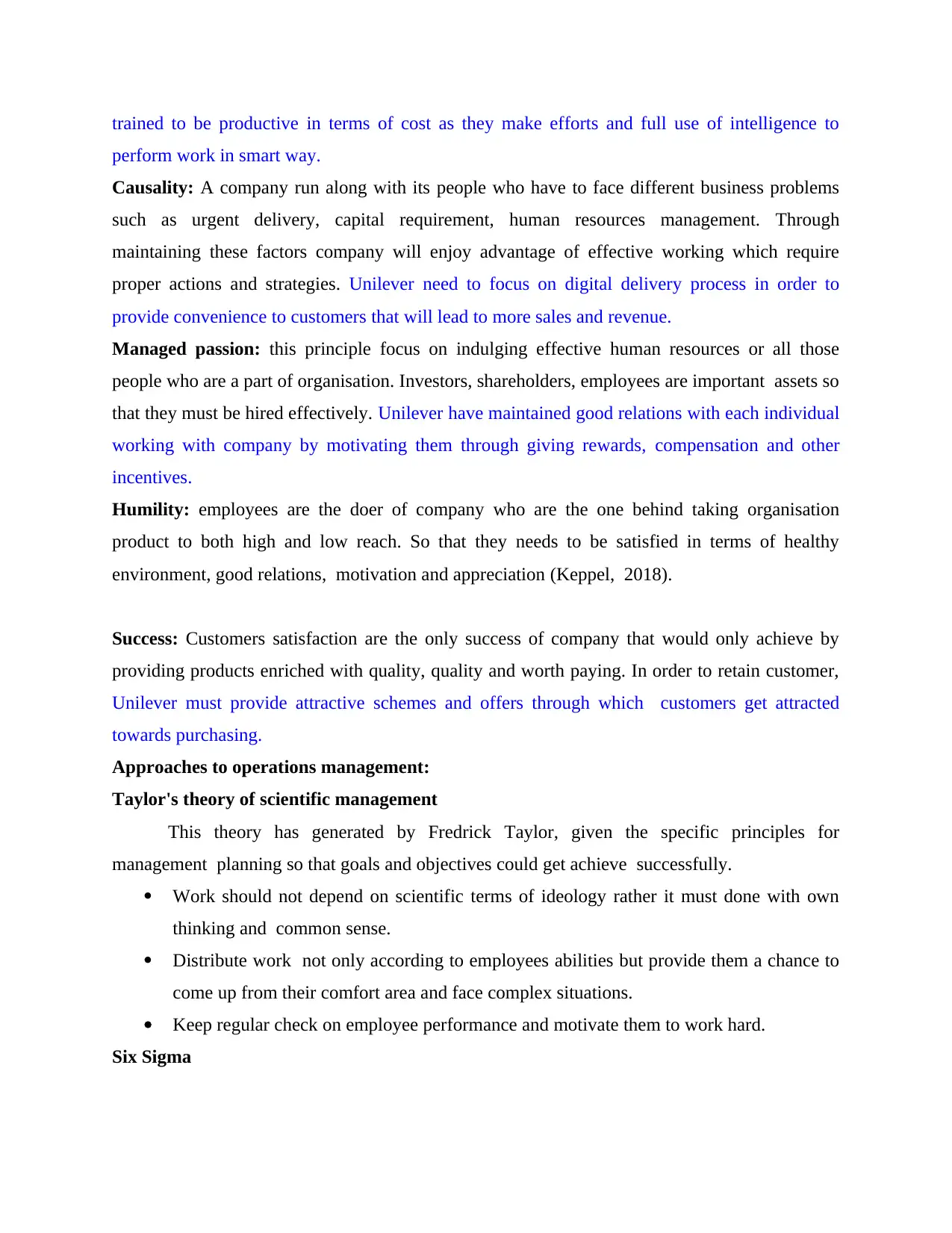
trained to be productive in terms of cost as they make efforts and full use of intelligence to
perform work in smart way.
Causality: A company run along with its people who have to face different business problems
such as urgent delivery, capital requirement, human resources management. Through
maintaining these factors company will enjoy advantage of effective working which require
proper actions and strategies. Unilever need to focus on digital delivery process in order to
provide convenience to customers that will lead to more sales and revenue.
Managed passion: this principle focus on indulging effective human resources or all those
people who are a part of organisation. Investors, shareholders, employees are important assets so
that they must be hired effectively. Unilever have maintained good relations with each individual
working with company by motivating them through giving rewards, compensation and other
incentives.
Humility: employees are the doer of company who are the one behind taking organisation
product to both high and low reach. So that they needs to be satisfied in terms of healthy
environment, good relations, motivation and appreciation (Keppel, 2018).
Success: Customers satisfaction are the only success of company that would only achieve by
providing products enriched with quality, quality and worth paying. In order to retain customer,
Unilever must provide attractive schemes and offers through which customers get attracted
towards purchasing.
Approaches to operations management:
Taylor's theory of scientific management
This theory has generated by Fredrick Taylor, given the specific principles for
management planning so that goals and objectives could get achieve successfully.
Work should not depend on scientific terms of ideology rather it must done with own
thinking and common sense.
Distribute work not only according to employees abilities but provide them a chance to
come up from their comfort area and face complex situations.
Keep regular check on employee performance and motivate them to work hard.
Six Sigma
perform work in smart way.
Causality: A company run along with its people who have to face different business problems
such as urgent delivery, capital requirement, human resources management. Through
maintaining these factors company will enjoy advantage of effective working which require
proper actions and strategies. Unilever need to focus on digital delivery process in order to
provide convenience to customers that will lead to more sales and revenue.
Managed passion: this principle focus on indulging effective human resources or all those
people who are a part of organisation. Investors, shareholders, employees are important assets so
that they must be hired effectively. Unilever have maintained good relations with each individual
working with company by motivating them through giving rewards, compensation and other
incentives.
Humility: employees are the doer of company who are the one behind taking organisation
product to both high and low reach. So that they needs to be satisfied in terms of healthy
environment, good relations, motivation and appreciation (Keppel, 2018).
Success: Customers satisfaction are the only success of company that would only achieve by
providing products enriched with quality, quality and worth paying. In order to retain customer,
Unilever must provide attractive schemes and offers through which customers get attracted
towards purchasing.
Approaches to operations management:
Taylor's theory of scientific management
This theory has generated by Fredrick Taylor, given the specific principles for
management planning so that goals and objectives could get achieve successfully.
Work should not depend on scientific terms of ideology rather it must done with own
thinking and common sense.
Distribute work not only according to employees abilities but provide them a chance to
come up from their comfort area and face complex situations.
Keep regular check on employee performance and motivate them to work hard.
Six Sigma
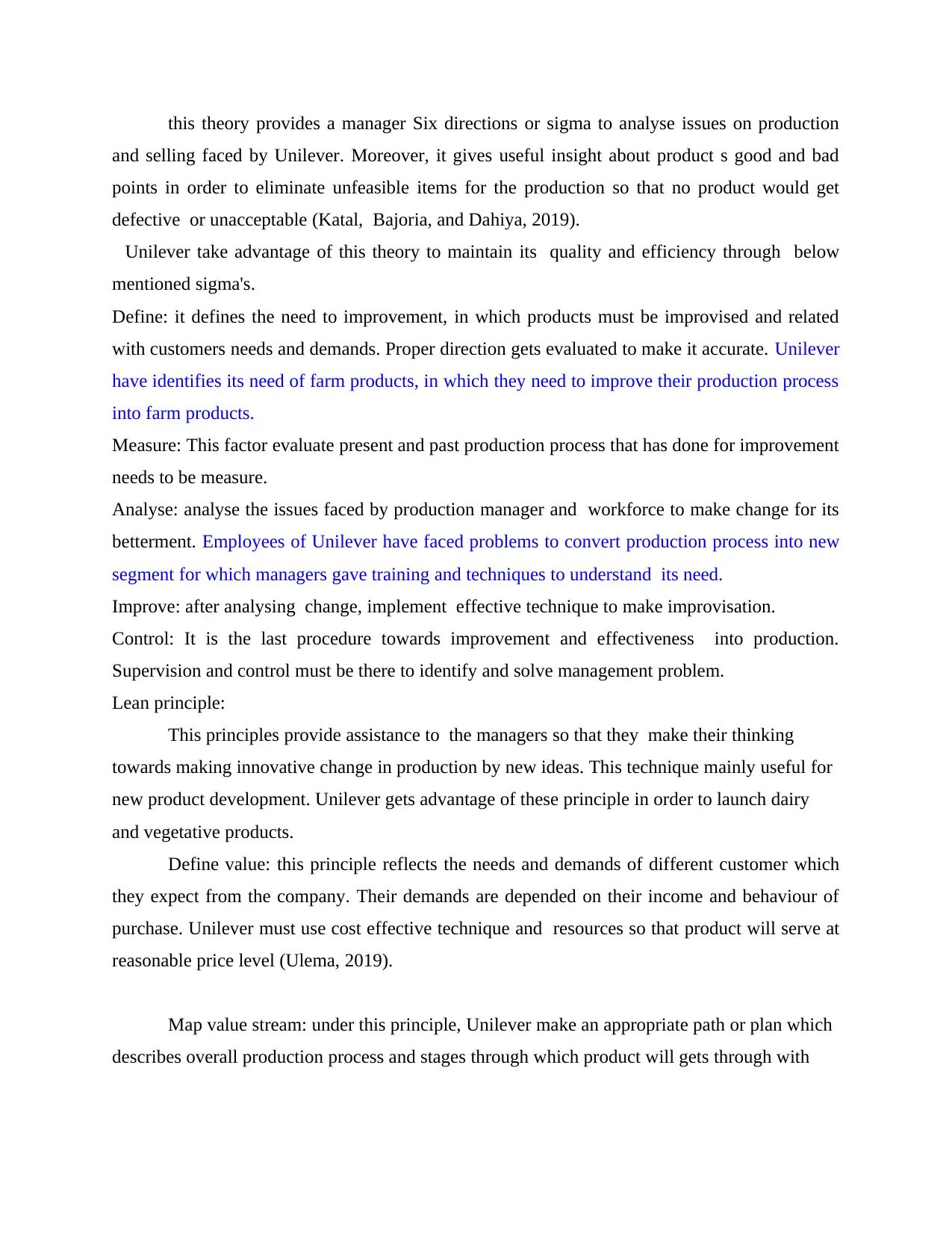
this theory provides a manager Six directions or sigma to analyse issues on production
and selling faced by Unilever. Moreover, it gives useful insight about product s good and bad
points in order to eliminate unfeasible items for the production so that no product would get
defective or unacceptable (Katal, Bajoria, and Dahiya, 2019).
Unilever take advantage of this theory to maintain its quality and efficiency through below
mentioned sigma's.
Define: it defines the need to improvement, in which products must be improvised and related
with customers needs and demands. Proper direction gets evaluated to make it accurate. Unilever
have identifies its need of farm products, in which they need to improve their production process
into farm products.
Measure: This factor evaluate present and past production process that has done for improvement
needs to be measure.
Analyse: analyse the issues faced by production manager and workforce to make change for its
betterment. Employees of Unilever have faced problems to convert production process into new
segment for which managers gave training and techniques to understand its need.
Improve: after analysing change, implement effective technique to make improvisation.
Control: It is the last procedure towards improvement and effectiveness into production.
Supervision and control must be there to identify and solve management problem.
Lean principle:
This principles provide assistance to the managers so that they make their thinking
towards making innovative change in production by new ideas. This technique mainly useful for
new product development. Unilever gets advantage of these principle in order to launch dairy
and vegetative products.
Define value: this principle reflects the needs and demands of different customer which
they expect from the company. Their demands are depended on their income and behaviour of
purchase. Unilever must use cost effective technique and resources so that product will serve at
reasonable price level (Ulema, 2019).
Map value stream: under this principle, Unilever make an appropriate path or plan which
describes overall production process and stages through which product will gets through with
and selling faced by Unilever. Moreover, it gives useful insight about product s good and bad
points in order to eliminate unfeasible items for the production so that no product would get
defective or unacceptable (Katal, Bajoria, and Dahiya, 2019).
Unilever take advantage of this theory to maintain its quality and efficiency through below
mentioned sigma's.
Define: it defines the need to improvement, in which products must be improvised and related
with customers needs and demands. Proper direction gets evaluated to make it accurate. Unilever
have identifies its need of farm products, in which they need to improve their production process
into farm products.
Measure: This factor evaluate present and past production process that has done for improvement
needs to be measure.
Analyse: analyse the issues faced by production manager and workforce to make change for its
betterment. Employees of Unilever have faced problems to convert production process into new
segment for which managers gave training and techniques to understand its need.
Improve: after analysing change, implement effective technique to make improvisation.
Control: It is the last procedure towards improvement and effectiveness into production.
Supervision and control must be there to identify and solve management problem.
Lean principle:
This principles provide assistance to the managers so that they make their thinking
towards making innovative change in production by new ideas. This technique mainly useful for
new product development. Unilever gets advantage of these principle in order to launch dairy
and vegetative products.
Define value: this principle reflects the needs and demands of different customer which
they expect from the company. Their demands are depended on their income and behaviour of
purchase. Unilever must use cost effective technique and resources so that product will serve at
reasonable price level (Ulema, 2019).
Map value stream: under this principle, Unilever make an appropriate path or plan which
describes overall production process and stages through which product will gets through with
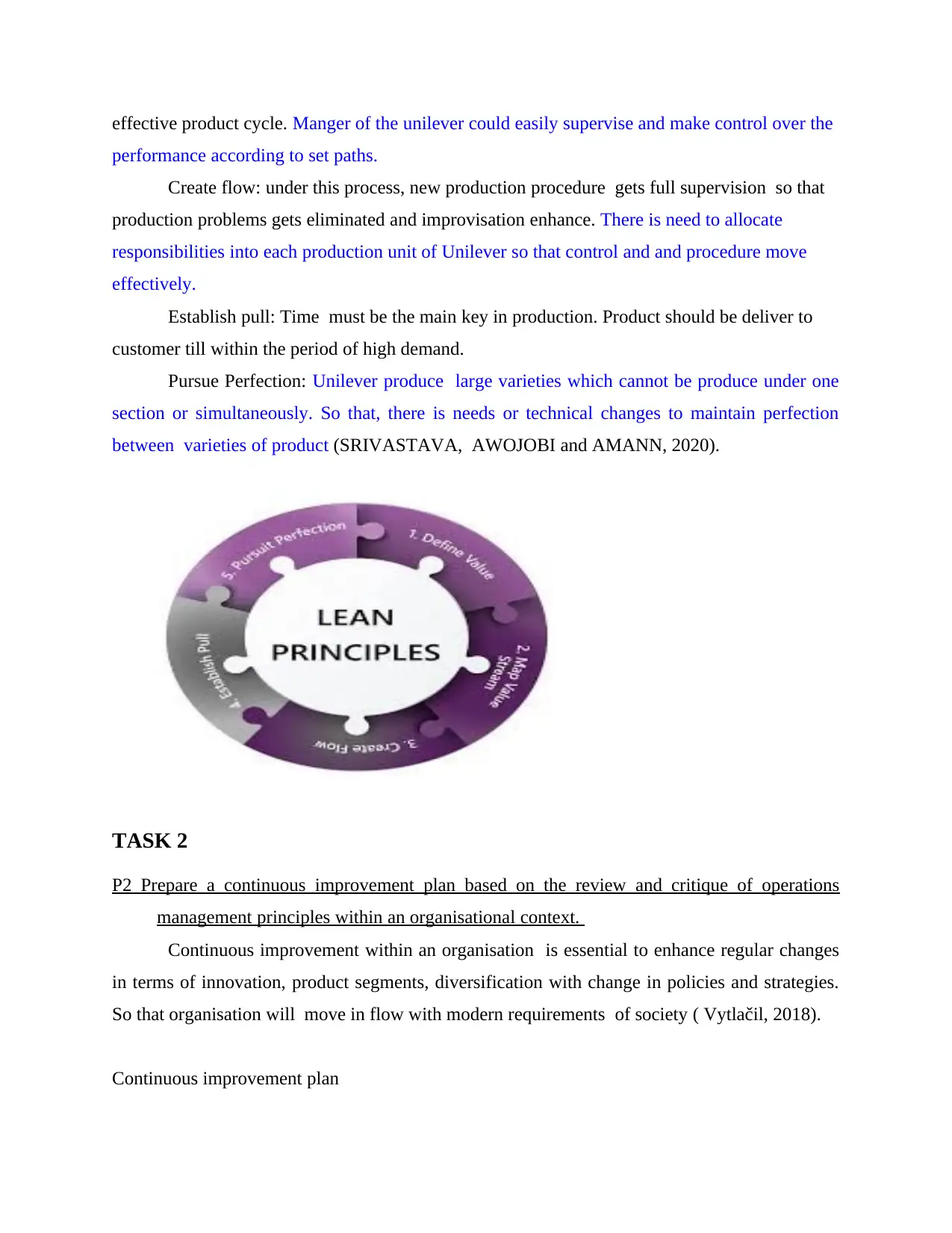
effective product cycle. Manger of the unilever could easily supervise and make control over the
performance according to set paths.
Create flow: under this process, new production procedure gets full supervision so that
production problems gets eliminated and improvisation enhance. There is need to allocate
responsibilities into each production unit of Unilever so that control and and procedure move
effectively.
Establish pull: Time must be the main key in production. Product should be deliver to
customer till within the period of high demand.
Pursue Perfection: Unilever produce large varieties which cannot be produce under one
section or simultaneously. So that, there is needs or technical changes to maintain perfection
between varieties of product (SRIVASTAVA, AWOJOBI and AMANN, 2020).
TASK 2
P2 Prepare a continuous improvement plan based on the review and critique of operations
management principles within an organisational context.
Continuous improvement within an organisation is essential to enhance regular changes
in terms of innovation, product segments, diversification with change in policies and strategies.
So that organisation will move in flow with modern requirements of society ( Vytlačil, 2018).
Continuous improvement plan
performance according to set paths.
Create flow: under this process, new production procedure gets full supervision so that
production problems gets eliminated and improvisation enhance. There is need to allocate
responsibilities into each production unit of Unilever so that control and and procedure move
effectively.
Establish pull: Time must be the main key in production. Product should be deliver to
customer till within the period of high demand.
Pursue Perfection: Unilever produce large varieties which cannot be produce under one
section or simultaneously. So that, there is needs or technical changes to maintain perfection
between varieties of product (SRIVASTAVA, AWOJOBI and AMANN, 2020).
TASK 2
P2 Prepare a continuous improvement plan based on the review and critique of operations
management principles within an organisational context.
Continuous improvement within an organisation is essential to enhance regular changes
in terms of innovation, product segments, diversification with change in policies and strategies.
So that organisation will move in flow with modern requirements of society ( Vytlačil, 2018).
Continuous improvement plan
Paraphrase This Document
Need a fresh take? Get an instant paraphrase of this document with our AI Paraphraser
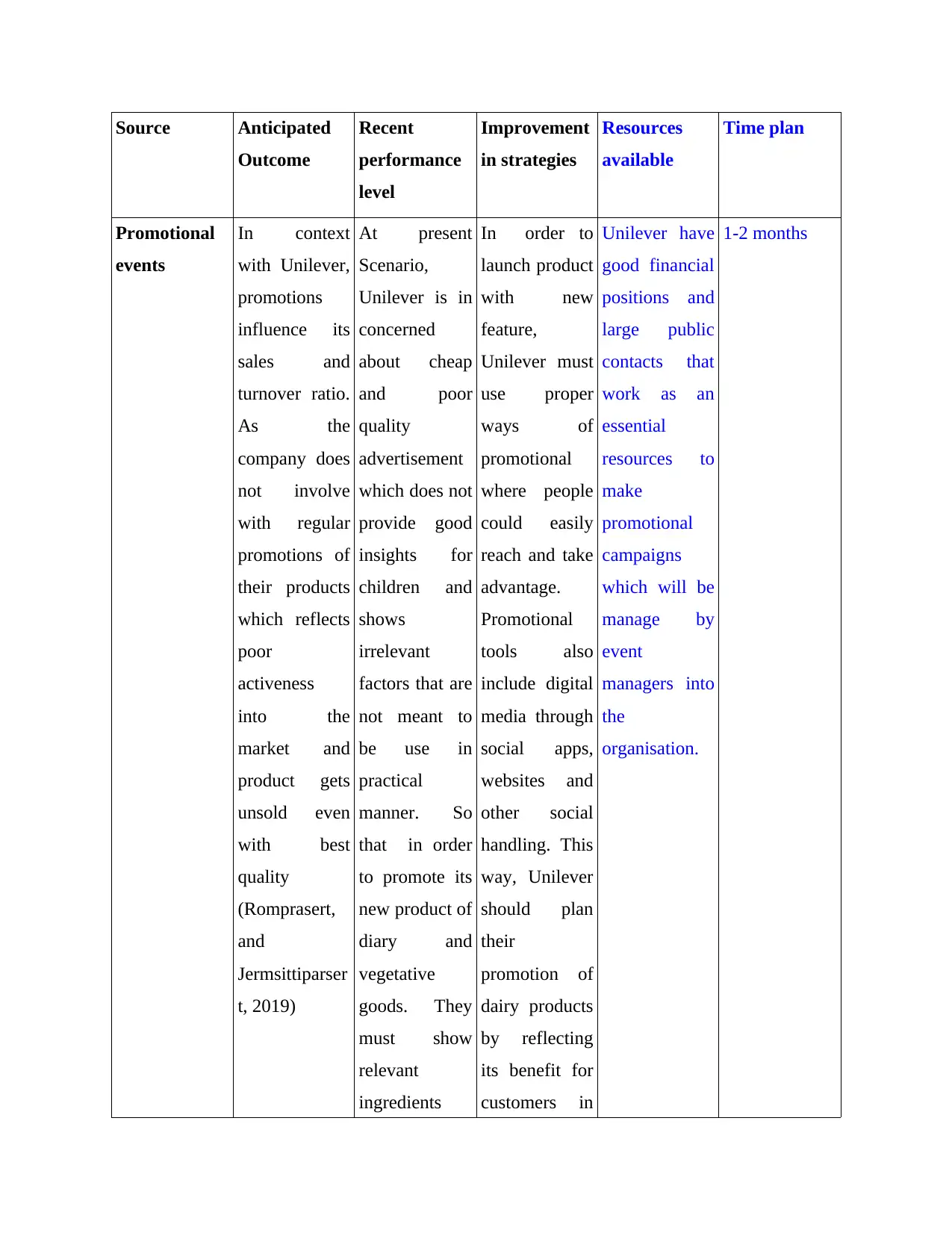
Source Anticipated
Outcome
Recent
performance
level
Improvement
in strategies
Resources
available
Time plan
Promotional
events
In context
with Unilever,
promotions
influence its
sales and
turnover ratio.
As the
company does
not involve
with regular
promotions of
their products
which reflects
poor
activeness
into the
market and
product gets
unsold even
with best
quality
(Romprasert,
and
Jermsittiparser
t, 2019)
At present
Scenario,
Unilever is in
concerned
about cheap
and poor
quality
advertisement
which does not
provide good
insights for
children and
shows
irrelevant
factors that are
not meant to
be use in
practical
manner. So
that in order
to promote its
new product of
diary and
vegetative
goods. They
must show
relevant
ingredients
In order to
launch product
with new
feature,
Unilever must
use proper
ways of
promotional
where people
could easily
reach and take
advantage.
Promotional
tools also
include digital
media through
social apps,
websites and
other social
handling. This
way, Unilever
should plan
their
promotion of
dairy products
by reflecting
its benefit for
customers in
Unilever have
good financial
positions and
large public
contacts that
work as an
essential
resources to
make
promotional
campaigns
which will be
manage by
event
managers into
the
organisation.
1-2 months
Outcome
Recent
performance
level
Improvement
in strategies
Resources
available
Time plan
Promotional
events
In context
with Unilever,
promotions
influence its
sales and
turnover ratio.
As the
company does
not involve
with regular
promotions of
their products
which reflects
poor
activeness
into the
market and
product gets
unsold even
with best
quality
(Romprasert,
and
Jermsittiparser
t, 2019)
At present
Scenario,
Unilever is in
concerned
about cheap
and poor
quality
advertisement
which does not
provide good
insights for
children and
shows
irrelevant
factors that are
not meant to
be use in
practical
manner. So
that in order
to promote its
new product of
diary and
vegetative
goods. They
must show
relevant
ingredients
In order to
launch product
with new
feature,
Unilever must
use proper
ways of
promotional
where people
could easily
reach and take
advantage.
Promotional
tools also
include digital
media through
social apps,
websites and
other social
handling. This
way, Unilever
should plan
their
promotion of
dairy products
by reflecting
its benefit for
customers in
Unilever have
good financial
positions and
large public
contacts that
work as an
essential
resources to
make
promotional
campaigns
which will be
manage by
event
managers into
the
organisation.
1-2 months
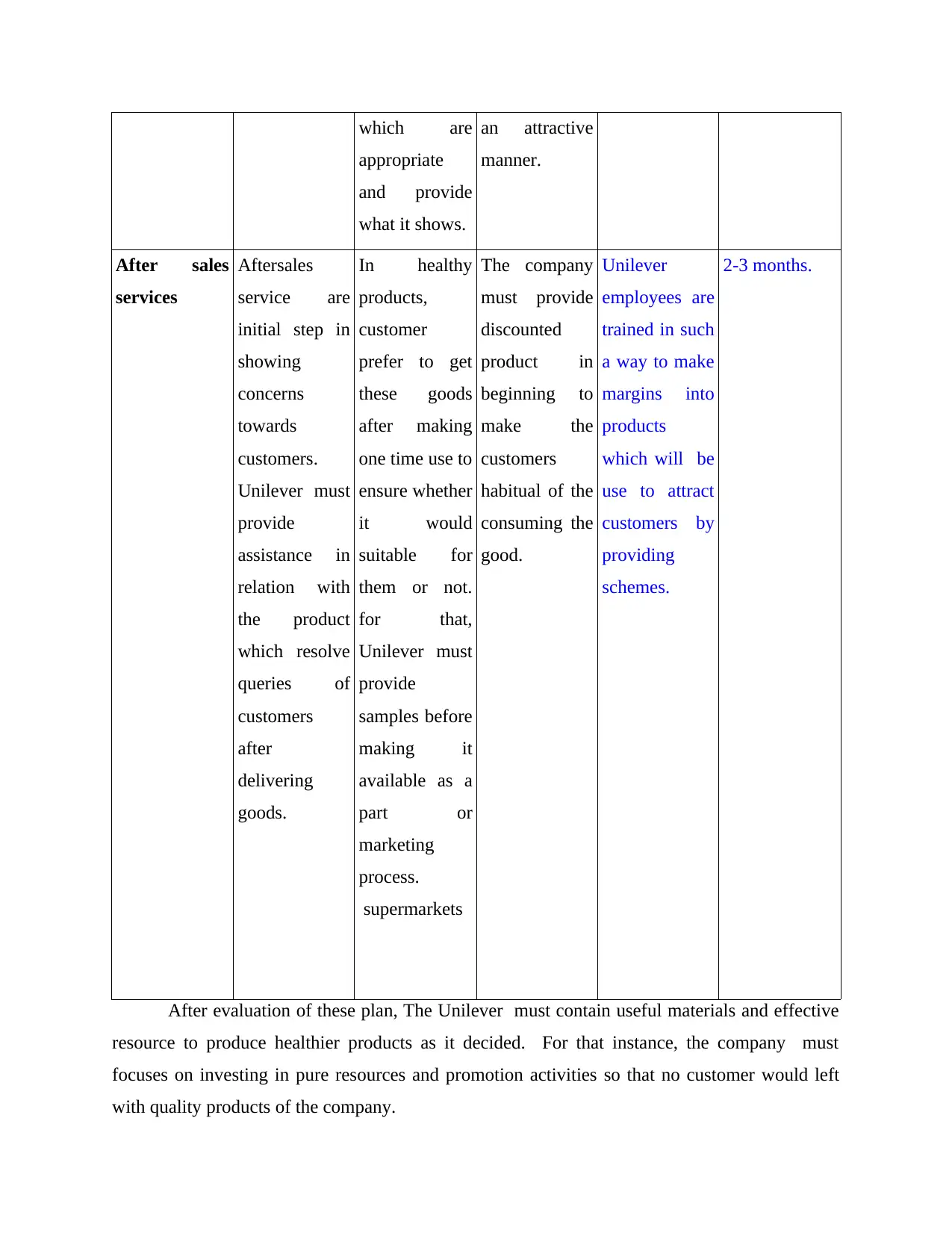
which are
appropriate
and provide
what it shows.
an attractive
manner.
After sales
services
Aftersales
service are
initial step in
showing
concerns
towards
customers.
Unilever must
provide
assistance in
relation with
the product
which resolve
queries of
customers
after
delivering
goods.
In healthy
products,
customer
prefer to get
these goods
after making
one time use to
ensure whether
it would
suitable for
them or not.
for that,
Unilever must
provide
samples before
making it
available as a
part or
marketing
process.
supermarkets
The company
must provide
discounted
product in
beginning to
make the
customers
habitual of the
consuming the
good.
Unilever
employees are
trained in such
a way to make
margins into
products
which will be
use to attract
customers by
providing
schemes.
2-3 months.
After evaluation of these plan, The Unilever must contain useful materials and effective
resource to produce healthier products as it decided. For that instance, the company must
focuses on investing in pure resources and promotion activities so that no customer would left
with quality products of the company.
appropriate
and provide
what it shows.
an attractive
manner.
After sales
services
Aftersales
service are
initial step in
showing
concerns
towards
customers.
Unilever must
provide
assistance in
relation with
the product
which resolve
queries of
customers
after
delivering
goods.
In healthy
products,
customer
prefer to get
these goods
after making
one time use to
ensure whether
it would
suitable for
them or not.
for that,
Unilever must
provide
samples before
making it
available as a
part or
marketing
process.
supermarkets
The company
must provide
discounted
product in
beginning to
make the
customers
habitual of the
consuming the
good.
Unilever
employees are
trained in such
a way to make
margins into
products
which will be
use to attract
customers by
providing
schemes.
2-3 months.
After evaluation of these plan, The Unilever must contain useful materials and effective
resource to produce healthier products as it decided. For that instance, the company must
focuses on investing in pure resources and promotion activities so that no customer would left
with quality products of the company.
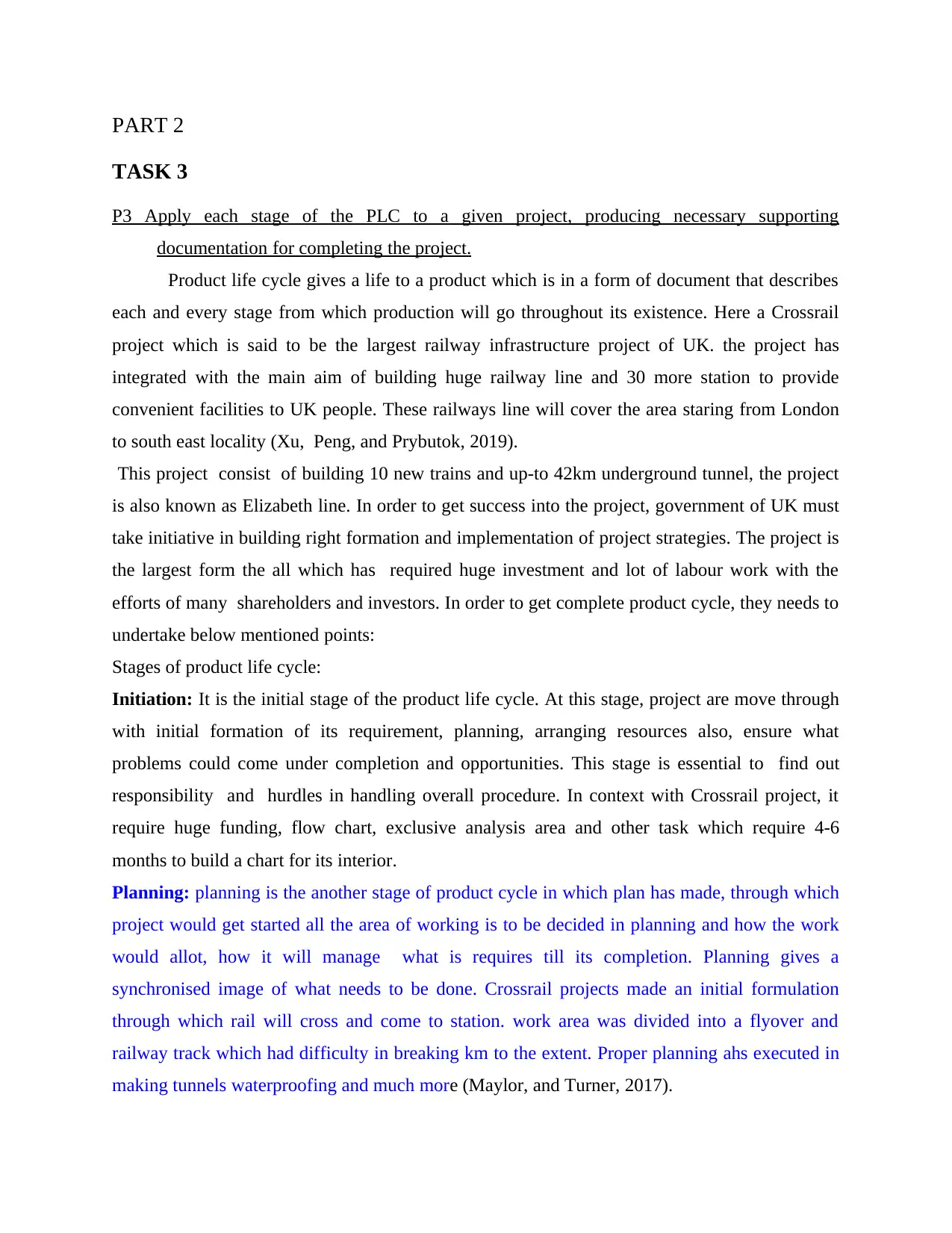
PART 2
TASK 3
P3 Apply each stage of the PLC to a given project, producing necessary supporting
documentation for completing the project.
Product life cycle gives a life to a product which is in a form of document that describes
each and every stage from which production will go throughout its existence. Here a Crossrail
project which is said to be the largest railway infrastructure project of UK. the project has
integrated with the main aim of building huge railway line and 30 more station to provide
convenient facilities to UK people. These railways line will cover the area staring from London
to south east locality (Xu, Peng, and Prybutok, 2019).
This project consist of building 10 new trains and up-to 42km underground tunnel, the project
is also known as Elizabeth line. In order to get success into the project, government of UK must
take initiative in building right formation and implementation of project strategies. The project is
the largest form the all which has required huge investment and lot of labour work with the
efforts of many shareholders and investors. In order to get complete product cycle, they needs to
undertake below mentioned points:
Stages of product life cycle:
Initiation: It is the initial stage of the product life cycle. At this stage, project are move through
with initial formation of its requirement, planning, arranging resources also, ensure what
problems could come under completion and opportunities. This stage is essential to find out
responsibility and hurdles in handling overall procedure. In context with Crossrail project, it
require huge funding, flow chart, exclusive analysis area and other task which require 4-6
months to build a chart for its interior.
Planning: planning is the another stage of product cycle in which plan has made, through which
project would get started all the area of working is to be decided in planning and how the work
would allot, how it will manage what is requires till its completion. Planning gives a
synchronised image of what needs to be done. Crossrail projects made an initial formulation
through which rail will cross and come to station. work area was divided into a flyover and
railway track which had difficulty in breaking km to the extent. Proper planning ahs executed in
making tunnels waterproofing and much more (Maylor, and Turner, 2017).
TASK 3
P3 Apply each stage of the PLC to a given project, producing necessary supporting
documentation for completing the project.
Product life cycle gives a life to a product which is in a form of document that describes
each and every stage from which production will go throughout its existence. Here a Crossrail
project which is said to be the largest railway infrastructure project of UK. the project has
integrated with the main aim of building huge railway line and 30 more station to provide
convenient facilities to UK people. These railways line will cover the area staring from London
to south east locality (Xu, Peng, and Prybutok, 2019).
This project consist of building 10 new trains and up-to 42km underground tunnel, the project
is also known as Elizabeth line. In order to get success into the project, government of UK must
take initiative in building right formation and implementation of project strategies. The project is
the largest form the all which has required huge investment and lot of labour work with the
efforts of many shareholders and investors. In order to get complete product cycle, they needs to
undertake below mentioned points:
Stages of product life cycle:
Initiation: It is the initial stage of the product life cycle. At this stage, project are move through
with initial formation of its requirement, planning, arranging resources also, ensure what
problems could come under completion and opportunities. This stage is essential to find out
responsibility and hurdles in handling overall procedure. In context with Crossrail project, it
require huge funding, flow chart, exclusive analysis area and other task which require 4-6
months to build a chart for its interior.
Planning: planning is the another stage of product cycle in which plan has made, through which
project would get started all the area of working is to be decided in planning and how the work
would allot, how it will manage what is requires till its completion. Planning gives a
synchronised image of what needs to be done. Crossrail projects made an initial formulation
through which rail will cross and come to station. work area was divided into a flyover and
railway track which had difficulty in breaking km to the extent. Proper planning ahs executed in
making tunnels waterproofing and much more (Maylor, and Turner, 2017).
Secure Best Marks with AI Grader
Need help grading? Try our AI Grader for instant feedback on your assignments.
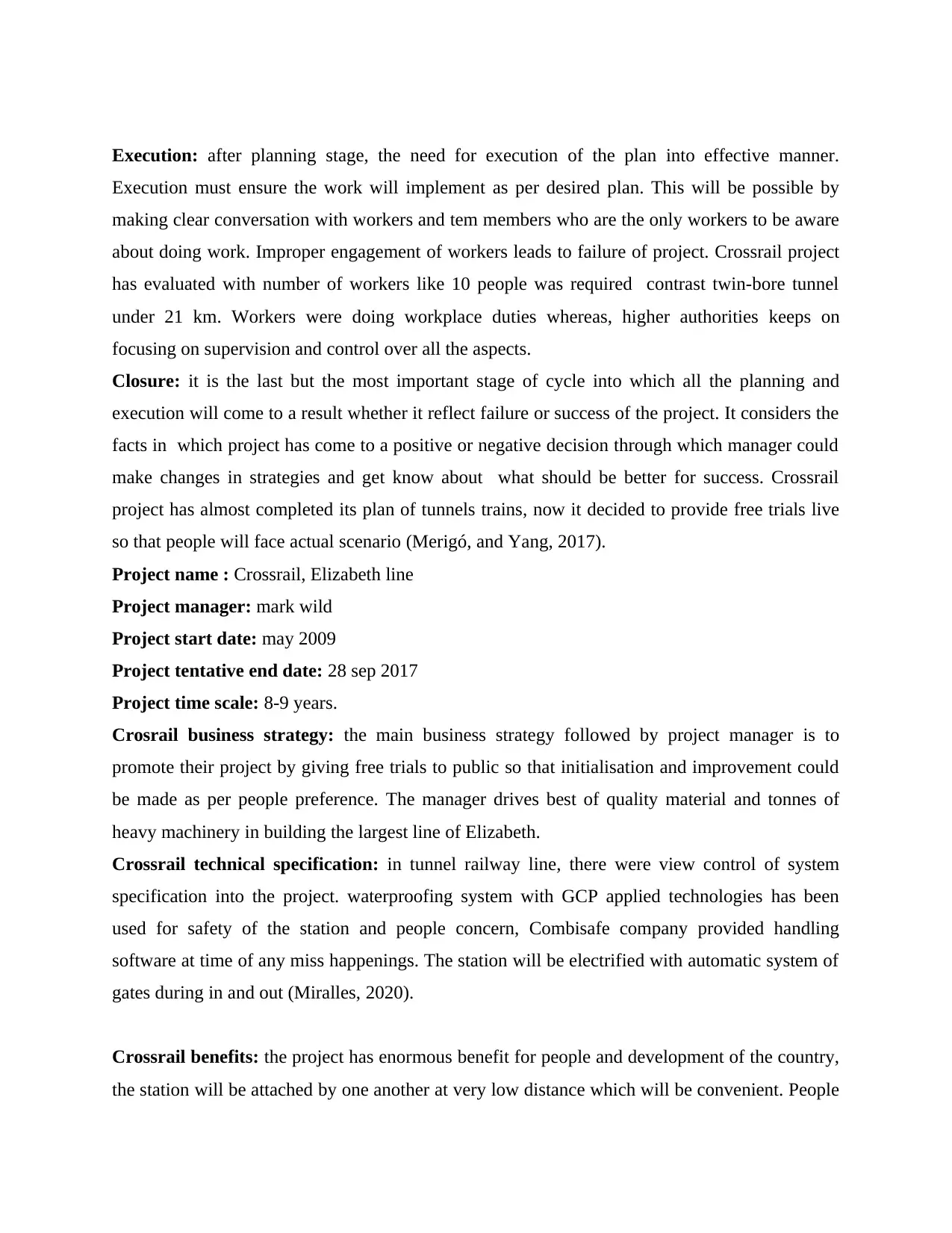
Execution: after planning stage, the need for execution of the plan into effective manner.
Execution must ensure the work will implement as per desired plan. This will be possible by
making clear conversation with workers and tem members who are the only workers to be aware
about doing work. Improper engagement of workers leads to failure of project. Crossrail project
has evaluated with number of workers like 10 people was required contrast twin-bore tunnel
under 21 km. Workers were doing workplace duties whereas, higher authorities keeps on
focusing on supervision and control over all the aspects.
Closure: it is the last but the most important stage of cycle into which all the planning and
execution will come to a result whether it reflect failure or success of the project. It considers the
facts in which project has come to a positive or negative decision through which manager could
make changes in strategies and get know about what should be better for success. Crossrail
project has almost completed its plan of tunnels trains, now it decided to provide free trials live
so that people will face actual scenario (Merigó, and Yang, 2017).
Project name : Crossrail, Elizabeth line
Project manager: mark wild
Project start date: may 2009
Project tentative end date: 28 sep 2017
Project time scale: 8-9 years.
Crosrail business strategy: the main business strategy followed by project manager is to
promote their project by giving free trials to public so that initialisation and improvement could
be made as per people preference. The manager drives best of quality material and tonnes of
heavy machinery in building the largest line of Elizabeth.
Crossrail technical specification: in tunnel railway line, there were view control of system
specification into the project. waterproofing system with GCP applied technologies has been
used for safety of the station and people concern, Combisafe company provided handling
software at time of any miss happenings. The station will be electrified with automatic system of
gates during in and out (Miralles, 2020).
Crossrail benefits: the project has enormous benefit for people and development of the country,
the station will be attached by one another at very low distance which will be convenient. People
Execution must ensure the work will implement as per desired plan. This will be possible by
making clear conversation with workers and tem members who are the only workers to be aware
about doing work. Improper engagement of workers leads to failure of project. Crossrail project
has evaluated with number of workers like 10 people was required contrast twin-bore tunnel
under 21 km. Workers were doing workplace duties whereas, higher authorities keeps on
focusing on supervision and control over all the aspects.
Closure: it is the last but the most important stage of cycle into which all the planning and
execution will come to a result whether it reflect failure or success of the project. It considers the
facts in which project has come to a positive or negative decision through which manager could
make changes in strategies and get know about what should be better for success. Crossrail
project has almost completed its plan of tunnels trains, now it decided to provide free trials live
so that people will face actual scenario (Merigó, and Yang, 2017).
Project name : Crossrail, Elizabeth line
Project manager: mark wild
Project start date: may 2009
Project tentative end date: 28 sep 2017
Project time scale: 8-9 years.
Crosrail business strategy: the main business strategy followed by project manager is to
promote their project by giving free trials to public so that initialisation and improvement could
be made as per people preference. The manager drives best of quality material and tonnes of
heavy machinery in building the largest line of Elizabeth.
Crossrail technical specification: in tunnel railway line, there were view control of system
specification into the project. waterproofing system with GCP applied technologies has been
used for safety of the station and people concern, Combisafe company provided handling
software at time of any miss happenings. The station will be electrified with automatic system of
gates during in and out (Miralles, 2020).
Crossrail benefits: the project has enormous benefit for people and development of the country,
the station will be attached by one another at very low distance which will be convenient. People
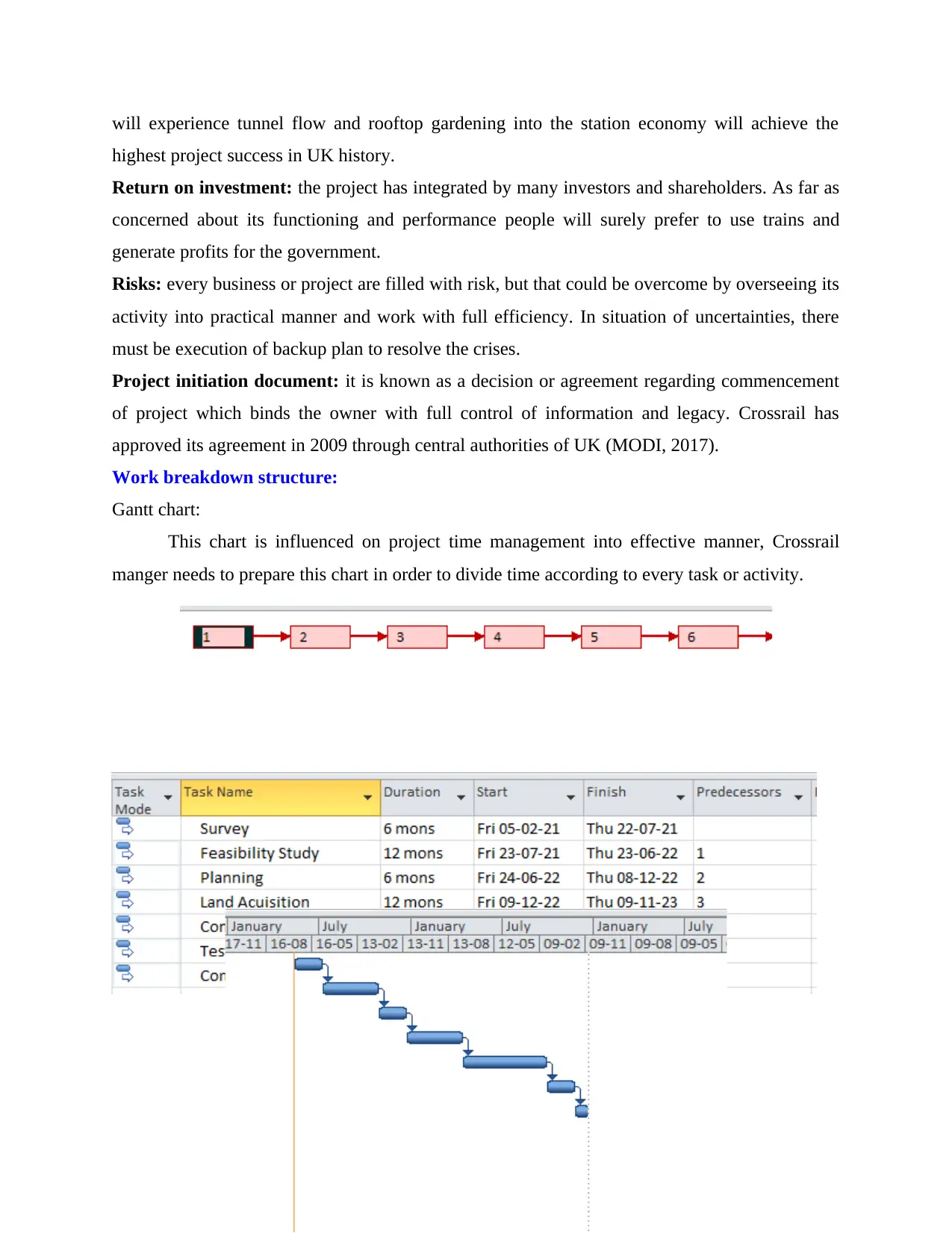
will experience tunnel flow and rooftop gardening into the station economy will achieve the
highest project success in UK history.
Return on investment: the project has integrated by many investors and shareholders. As far as
concerned about its functioning and performance people will surely prefer to use trains and
generate profits for the government.
Risks: every business or project are filled with risk, but that could be overcome by overseeing its
activity into practical manner and work with full efficiency. In situation of uncertainties, there
must be execution of backup plan to resolve the crises.
Project initiation document: it is known as a decision or agreement regarding commencement
of project which binds the owner with full control of information and legacy. Crossrail has
approved its agreement in 2009 through central authorities of UK (MODI, 2017).
Work breakdown structure:
Gantt chart:
This chart is influenced on project time management into effective manner, Crossrail
manger needs to prepare this chart in order to divide time according to every task or activity.
highest project success in UK history.
Return on investment: the project has integrated by many investors and shareholders. As far as
concerned about its functioning and performance people will surely prefer to use trains and
generate profits for the government.
Risks: every business or project are filled with risk, but that could be overcome by overseeing its
activity into practical manner and work with full efficiency. In situation of uncertainties, there
must be execution of backup plan to resolve the crises.
Project initiation document: it is known as a decision or agreement regarding commencement
of project which binds the owner with full control of information and legacy. Crossrail has
approved its agreement in 2009 through central authorities of UK (MODI, 2017).
Work breakdown structure:
Gantt chart:
This chart is influenced on project time management into effective manner, Crossrail
manger needs to prepare this chart in order to divide time according to every task or activity.
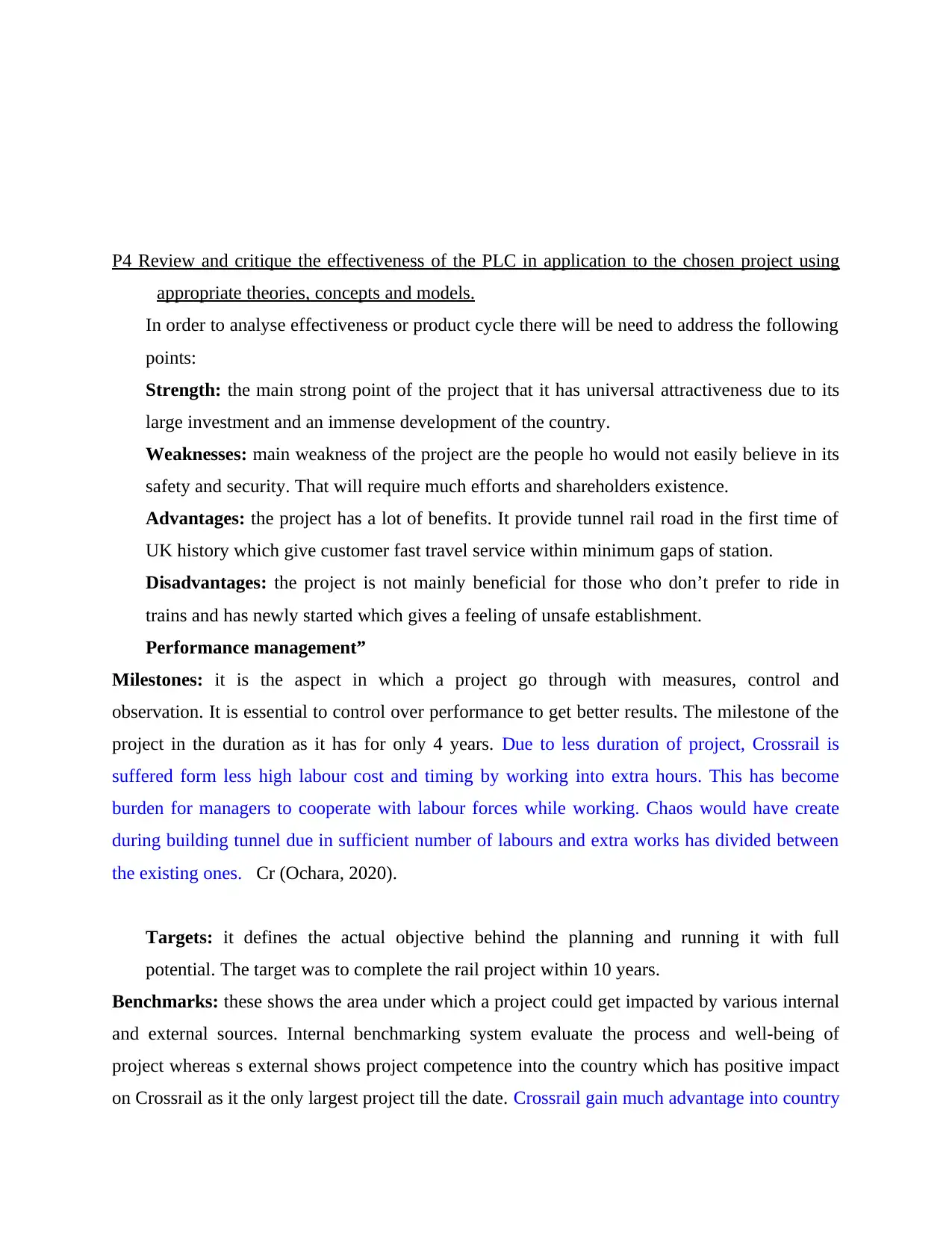
P4 Review and critique the effectiveness of the PLC in application to the chosen project using
appropriate theories, concepts and models.
In order to analyse effectiveness or product cycle there will be need to address the following
points:
Strength: the main strong point of the project that it has universal attractiveness due to its
large investment and an immense development of the country.
Weaknesses: main weakness of the project are the people ho would not easily believe in its
safety and security. That will require much efforts and shareholders existence.
Advantages: the project has a lot of benefits. It provide tunnel rail road in the first time of
UK history which give customer fast travel service within minimum gaps of station.
Disadvantages: the project is not mainly beneficial for those who don’t prefer to ride in
trains and has newly started which gives a feeling of unsafe establishment.
Performance management”
Milestones: it is the aspect in which a project go through with measures, control and
observation. It is essential to control over performance to get better results. The milestone of the
project in the duration as it has for only 4 years. Due to less duration of project, Crossrail is
suffered form less high labour cost and timing by working into extra hours. This has become
burden for managers to cooperate with labour forces while working. Chaos would have create
during building tunnel due in sufficient number of labours and extra works has divided between
the existing ones. Cr (Ochara, 2020).
Targets: it defines the actual objective behind the planning and running it with full
potential. The target was to complete the rail project within 10 years.
Benchmarks: these shows the area under which a project could get impacted by various internal
and external sources. Internal benchmarking system evaluate the process and well-being of
project whereas s external shows project competence into the country which has positive impact
on Crossrail as it the only largest project till the date. Crossrail gain much advantage into country
appropriate theories, concepts and models.
In order to analyse effectiveness or product cycle there will be need to address the following
points:
Strength: the main strong point of the project that it has universal attractiveness due to its
large investment and an immense development of the country.
Weaknesses: main weakness of the project are the people ho would not easily believe in its
safety and security. That will require much efforts and shareholders existence.
Advantages: the project has a lot of benefits. It provide tunnel rail road in the first time of
UK history which give customer fast travel service within minimum gaps of station.
Disadvantages: the project is not mainly beneficial for those who don’t prefer to ride in
trains and has newly started which gives a feeling of unsafe establishment.
Performance management”
Milestones: it is the aspect in which a project go through with measures, control and
observation. It is essential to control over performance to get better results. The milestone of the
project in the duration as it has for only 4 years. Due to less duration of project, Crossrail is
suffered form less high labour cost and timing by working into extra hours. This has become
burden for managers to cooperate with labour forces while working. Chaos would have create
during building tunnel due in sufficient number of labours and extra works has divided between
the existing ones. Cr (Ochara, 2020).
Targets: it defines the actual objective behind the planning and running it with full
potential. The target was to complete the rail project within 10 years.
Benchmarks: these shows the area under which a project could get impacted by various internal
and external sources. Internal benchmarking system evaluate the process and well-being of
project whereas s external shows project competence into the country which has positive impact
on Crossrail as it the only largest project till the date. Crossrail gain much advantage into country
Paraphrase This Document
Need a fresh take? Get an instant paraphrase of this document with our AI Paraphraser
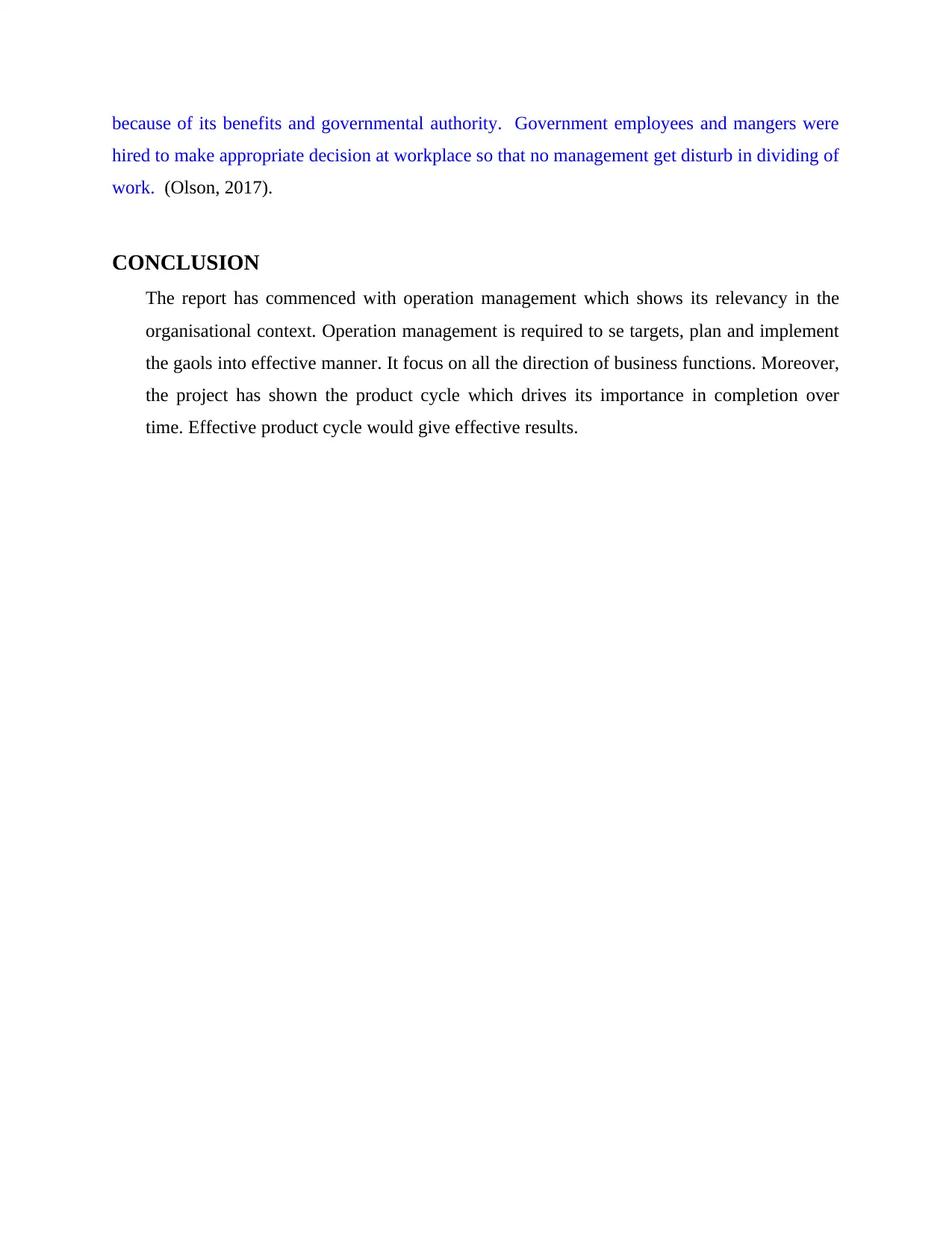
because of its benefits and governmental authority. Government employees and mangers were
hired to make appropriate decision at workplace so that no management get disturb in dividing of
work. (Olson, 2017).
CONCLUSION
The report has commenced with operation management which shows its relevancy in the
organisational context. Operation management is required to se targets, plan and implement
the gaols into effective manner. It focus on all the direction of business functions. Moreover,
the project has shown the product cycle which drives its importance in completion over
time. Effective product cycle would give effective results.
hired to make appropriate decision at workplace so that no management get disturb in dividing of
work. (Olson, 2017).
CONCLUSION
The report has commenced with operation management which shows its relevancy in the
organisational context. Operation management is required to se targets, plan and implement
the gaols into effective manner. It focus on all the direction of business functions. Moreover,
the project has shown the product cycle which drives its importance in completion over
time. Effective product cycle would give effective results.
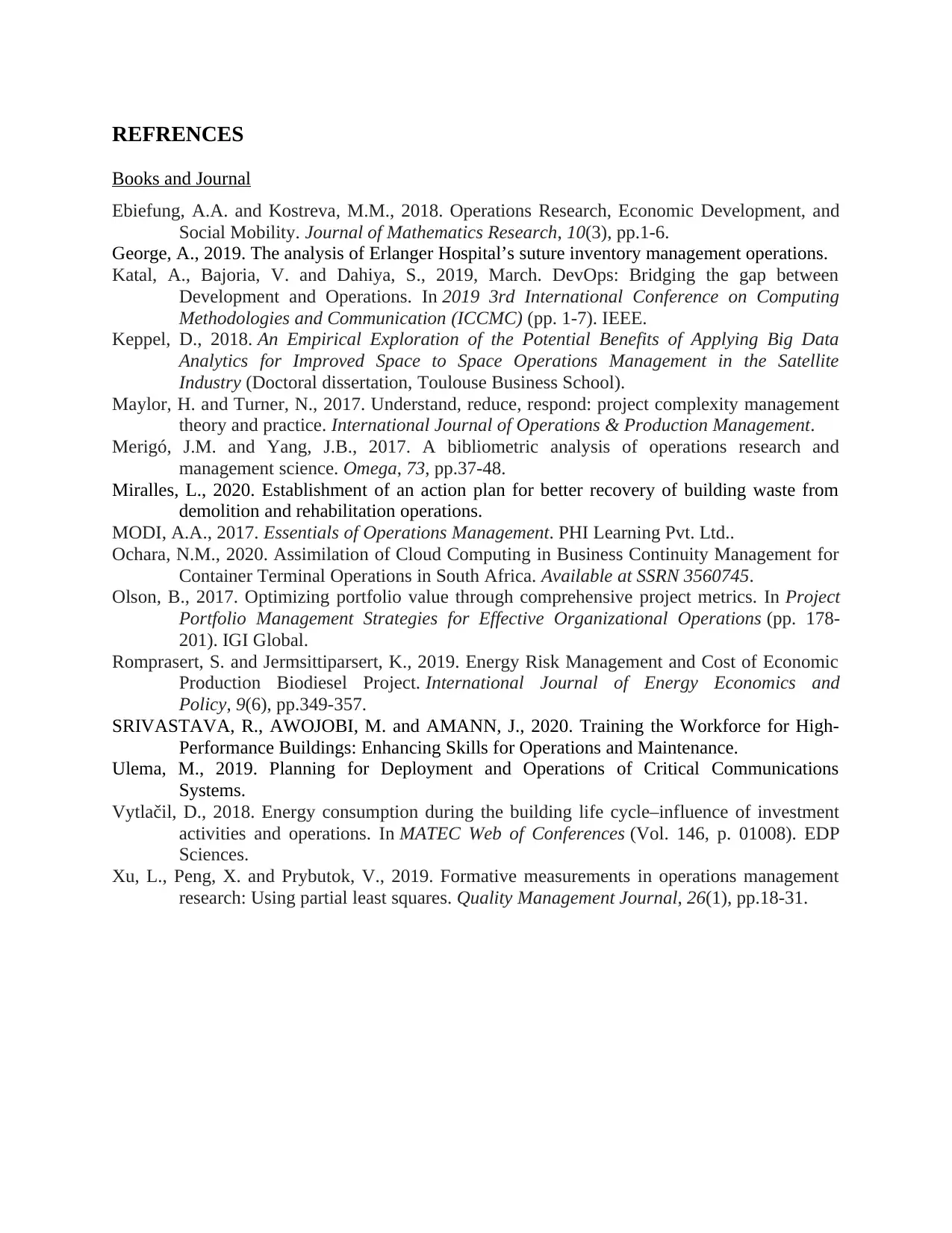
REFRENCES
Books and Journal
Ebiefung, A.A. and Kostreva, M.M., 2018. Operations Research, Economic Development, and
Social Mobility. Journal of Mathematics Research, 10(3), pp.1-6.
George, A., 2019. The analysis of Erlanger Hospital’s suture inventory management operations.
Katal, A., Bajoria, V. and Dahiya, S., 2019, March. DevOps: Bridging the gap between
Development and Operations. In 2019 3rd International Conference on Computing
Methodologies and Communication (ICCMC) (pp. 1-7). IEEE.
Keppel, D., 2018. An Empirical Exploration of the Potential Benefits of Applying Big Data
Analytics for Improved Space to Space Operations Management in the Satellite
Industry (Doctoral dissertation, Toulouse Business School).
Maylor, H. and Turner, N., 2017. Understand, reduce, respond: project complexity management
theory and practice. International Journal of Operations & Production Management.
Merigó, J.M. and Yang, J.B., 2017. A bibliometric analysis of operations research and
management science. Omega, 73, pp.37-48.
Miralles, L., 2020. Establishment of an action plan for better recovery of building waste from
demolition and rehabilitation operations.
MODI, A.A., 2017. Essentials of Operations Management. PHI Learning Pvt. Ltd..
Ochara, N.M., 2020. Assimilation of Cloud Computing in Business Continuity Management for
Container Terminal Operations in South Africa. Available at SSRN 3560745.
Olson, B., 2017. Optimizing portfolio value through comprehensive project metrics. In Project
Portfolio Management Strategies for Effective Organizational Operations (pp. 178-
201). IGI Global.
Romprasert, S. and Jermsittiparsert, K., 2019. Energy Risk Management and Cost of Economic
Production Biodiesel Project. International Journal of Energy Economics and
Policy, 9(6), pp.349-357.
SRIVASTAVA, R., AWOJOBI, M. and AMANN, J., 2020. Training the Workforce for High-
Performance Buildings: Enhancing Skills for Operations and Maintenance.
Ulema, M., 2019. Planning for Deployment and Operations of Critical Communications
Systems.
Vytlačil, D., 2018. Energy consumption during the building life cycle–influence of investment
activities and operations. In MATEC Web of Conferences (Vol. 146, p. 01008). EDP
Sciences.
Xu, L., Peng, X. and Prybutok, V., 2019. Formative measurements in operations management
research: Using partial least squares. Quality Management Journal, 26(1), pp.18-31.
Books and Journal
Ebiefung, A.A. and Kostreva, M.M., 2018. Operations Research, Economic Development, and
Social Mobility. Journal of Mathematics Research, 10(3), pp.1-6.
George, A., 2019. The analysis of Erlanger Hospital’s suture inventory management operations.
Katal, A., Bajoria, V. and Dahiya, S., 2019, March. DevOps: Bridging the gap between
Development and Operations. In 2019 3rd International Conference on Computing
Methodologies and Communication (ICCMC) (pp. 1-7). IEEE.
Keppel, D., 2018. An Empirical Exploration of the Potential Benefits of Applying Big Data
Analytics for Improved Space to Space Operations Management in the Satellite
Industry (Doctoral dissertation, Toulouse Business School).
Maylor, H. and Turner, N., 2017. Understand, reduce, respond: project complexity management
theory and practice. International Journal of Operations & Production Management.
Merigó, J.M. and Yang, J.B., 2017. A bibliometric analysis of operations research and
management science. Omega, 73, pp.37-48.
Miralles, L., 2020. Establishment of an action plan for better recovery of building waste from
demolition and rehabilitation operations.
MODI, A.A., 2017. Essentials of Operations Management. PHI Learning Pvt. Ltd..
Ochara, N.M., 2020. Assimilation of Cloud Computing in Business Continuity Management for
Container Terminal Operations in South Africa. Available at SSRN 3560745.
Olson, B., 2017. Optimizing portfolio value through comprehensive project metrics. In Project
Portfolio Management Strategies for Effective Organizational Operations (pp. 178-
201). IGI Global.
Romprasert, S. and Jermsittiparsert, K., 2019. Energy Risk Management and Cost of Economic
Production Biodiesel Project. International Journal of Energy Economics and
Policy, 9(6), pp.349-357.
SRIVASTAVA, R., AWOJOBI, M. and AMANN, J., 2020. Training the Workforce for High-
Performance Buildings: Enhancing Skills for Operations and Maintenance.
Ulema, M., 2019. Planning for Deployment and Operations of Critical Communications
Systems.
Vytlačil, D., 2018. Energy consumption during the building life cycle–influence of investment
activities and operations. In MATEC Web of Conferences (Vol. 146, p. 01008). EDP
Sciences.
Xu, L., Peng, X. and Prybutok, V., 2019. Formative measurements in operations management
research: Using partial least squares. Quality Management Journal, 26(1), pp.18-31.
1 out of 15
Related Documents
Your All-in-One AI-Powered Toolkit for Academic Success.
+13062052269
info@desklib.com
Available 24*7 on WhatsApp / Email
![[object Object]](/_next/static/media/star-bottom.7253800d.svg)
Unlock your academic potential
© 2024 | Zucol Services PVT LTD | All rights reserved.





